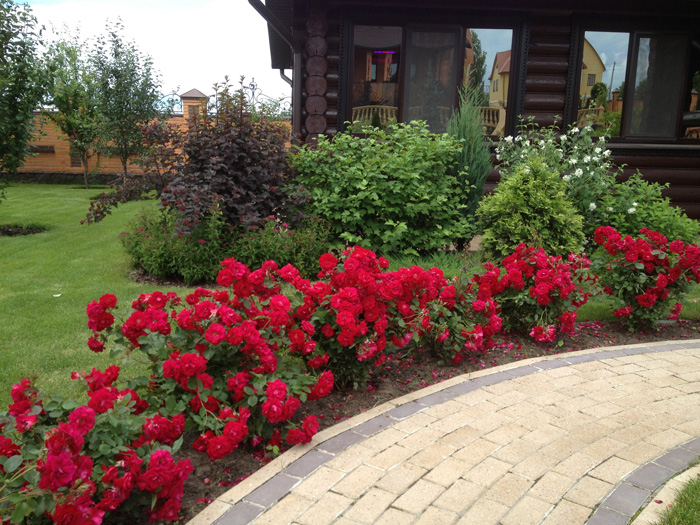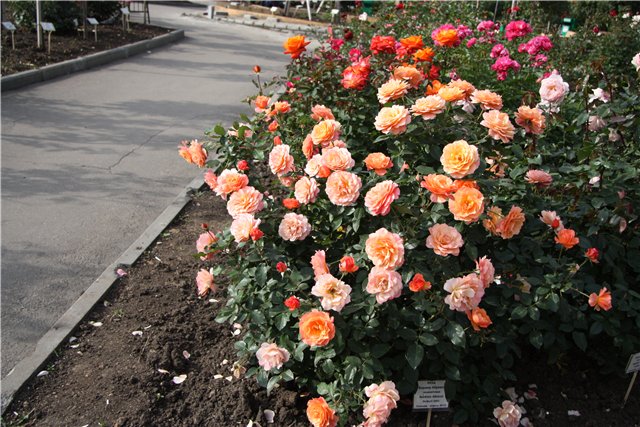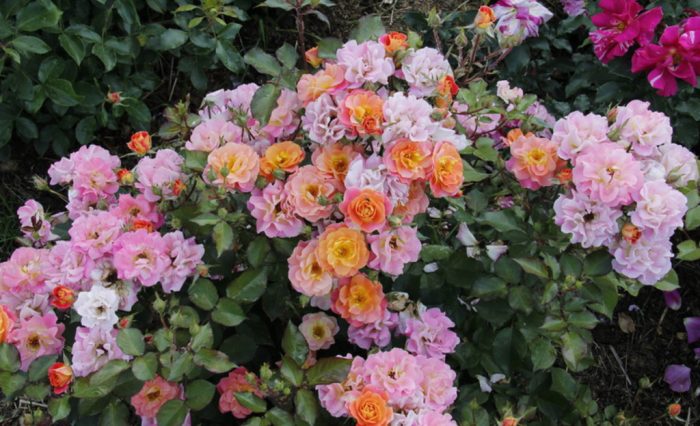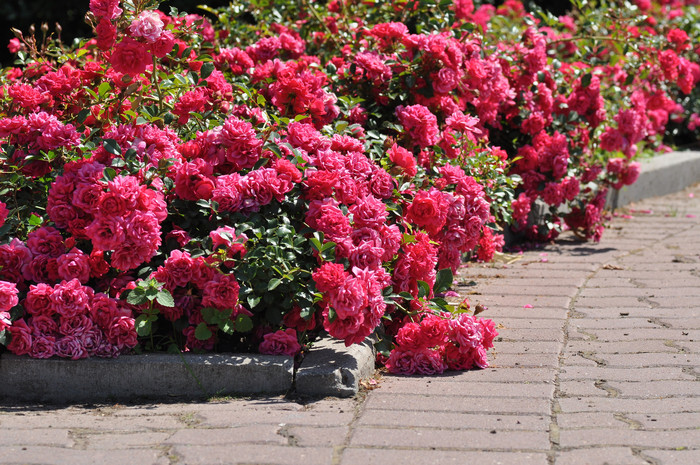Content:
Border roses are short (no more than 60 cm) shrub plants. Their homeland is China. They were first spoken about in the 19th century. Subsequently, these roses began to be crossed with floribunda roses.
Neat compact bushes do not take up much space, planting them in even rows will help create a beautiful design for a garden path or flower bed.
Characteristics of varieties of border roses
Miniature roses have a lot of colors. Moreover, on one bush, the shades of buds and flowers may differ. Sometimes the color of some changes over time. Yellow flowers appear in early summer, a little later pink begins to prevail on the bush, and later crimson shades appear.
Rose Border Apricot - floribunda, double flowers, delicate apricot shade. Their shape is goblet, but gradually becomes wider and flat. Consist of 7–25 petals. They have an average resistance to diseases, including powdery mildew.
The Bordure Camaieu rose is an example of a plant with multi-colored flowers. In the early stages of opening, their color is yellow-orange, and when they open completely they turn pink. One stem has 3-5 flowers. The height of the bush is about 60 cm. Camaieu rose has dense leaves, rich green color. Rose Border Kamae blooms profusely, continuously. Has a high winter hardiness. The scent of flowers is very delicate. For the Bordure Camaieu rose, a light, fertile soil with a slightly acidic reaction is suitable (pH = 5.6–6.5).
Rose border Bonnie - its lilac-pink flowers are collected in large inflorescences. The number of flowers on a branch reaches 10 pieces. Their diameter is about 6 cm. Each has up to 35 petals. The foliage is green, medium saturation. The plant has an average resistance to powdery mildew, black spot. Low resistance to the harmful effects of rain and moisture.
Interesting information for beginners
Those who first decided to plant curb roses on their site should first of all choose a well-lit place, protected from strong winds. Plants also suffer from a lack of light, stunted and lose their decorative effect.
Continuous flowering from early spring to the very frost is the main property of border roses, thanks to which their popularity is only growing.
Unlike other varieties of roses, curbs are planted not only in open ground, but also in separate containers, which are subsequently placed on the site or they decorate the entrance group of a house or cottage. They are a rather elegant decoration, as they bloom for a long time and abundantly.
Landing in open ground
In order for rose bushes to look smart and healthy for a long time, you need to properly organize their planting. These small plants are quite unpretentious and not particularly demanding on the properties of the soil. It is enough that it is not swampy and not too heavy.True, small roses also dislike overdried soil, since their roots are located close to the surface, and react sharply to a lack of moisture. There are the following rules for planting border roses:
- You can plant roses after the threat of spring frosts has passed, and the soil is well warmed up. This will facilitate rapid establishment and adaptation.
- It is necessary to dig a hole of sufficient depth, where the roots can freely fit, the length of which can be more than 30 cm.The depth of the hole should be at least 40 cm, and the diameter may be larger, since you will have to add humus, or even better - special soil for roses. Drainage should be placed on the bottom - gravel or small pieces of brick.
- The roots of the plant during planting must be well spread, the root collar must be immersed in the soil by about 4 cm.
- The soil around the plant is compacted and watered well.
The planting scheme should be such that a distance of at least 30 cm remains between the seedlings.But if it is assumed that the bushes will be quite spreading, you can leave 50 cm.
Care and feeding
Care and growing of border roses is not burdensome. Even meeting the minimum requirements for providing plants with favorable conditions gets a quick return - they grow healthy and bloom beautifully.
Water roses at the root, it is better to do this in the evening. During the day, the water is heated in the sun and does not stress the plant.
The bushes are fed several times throughout the season. Fertilizers are usually used for flowering ornamental plants or directly for roses. If possible, organic fertilizers are used, rotted manure is suitable, horse manure is best. It is thoroughly mixed with the soil and laid out under the bushes. Ripe compost can be applied in spring and autumn. For 1 m², it will need at least 5 kg. When buds appear, roses are watered with calcium nitrate (one tablespoon for 8-10 liters). So that the plant does not get burned, it is pre-watered, and after feeding, watering is repeated again. For full nutrition of the bushes, depending on their condition, every 20 days, you can feed them with organic and inorganic fertilizers, herbal infusions.
Pruning bushes
Since these small roses are always in the foreground in almost any landscape, special attention should be paid to pruning them. Sanitary work is carried out regularly, constantly removing dried branches that are sick or damaged by pests.
Pruning to get the correct shape of the bushes should be done as needed, but in the fall even before the onset of the first frost, so that the injured areas do not rot. A cut is made 5–8 mm from the kidney. Wild growth is removed at the neck level. Only in this case the wild will not grow back.
In young bushes of the first year of life, pinch all the shoots after the 4th and 5th leaves. The buds are removed. Central, vertical stems in older bushes are not cut, only lateral.
Pruning healthy branches can produce viable cuttings that are planted in prepared soil and covered with a plastic bottle. In the future, they are monitored and looked after in the same way as for cuttings of ordinary roses: they water and carefully weed out growing weeds on time.
Pest and disease control
Breeding and caring for small roses also means the destruction of insects that can harm them. To save roses from the appearance of aphids, spider mites, sawflies not far from them, you need to plant marigolds, onions, sage.
For preventive purposes, it is necessary to spray the plants with infusions of onions, garlic or calendula. In the periods preceding the appearance of pests, the soil must be sprinkled with ash.If the struggle with natural remedies has not yielded results, special insecticides should be used.
Powdery mildew, rust or black spot can be prevented by spraying with a 3% solution of copper sulfate or nitrophenol (2%).
Border roses in landscape design
Due to the fact that more and more new varieties of roses appear every year, landscape designers have the opportunity to bring any, even extraordinary, ideas to life. Live borders of small roses, original hedges and vertical flower beds are very popular nowadays.
Growing a curb garden of compact rose bushes along a garden path is now easy. They are beautiful from every angle. Floribunda and hybrid polyanthus roses are suitable. Seedlings of such varieties are used that will not grow more than 60-80 cm. Usually they are placed on both sides of the garden path.
Small roses are also used in the design of large vertical rose gardens using climbing and semi-climbing varieties. They decorate the lower part, covering areas of stems without leaves.
Often, to decorate various arches, pergolas and columns, multi-tiered ground structures are used. Experienced designers create the illusion of intertwining with flowers.
Before the onset of cold weather, the rose gardens are dismantled, and the plants in containers are transferred to a heated room, where they will continue to be looked after and grown as home flowers.
Border roses give the garden a fabulous and well-groomed look. They are unpretentious and are planted in large numbers every year in city parks, on flower beds in public gardens, they are used to decorate separate sections of streets and recreation areas, alpine slides. They are used not only to decorate the landscape, but also grown in the house. Since their variety and beauty of flowers has no competitors among indoor plants.

















